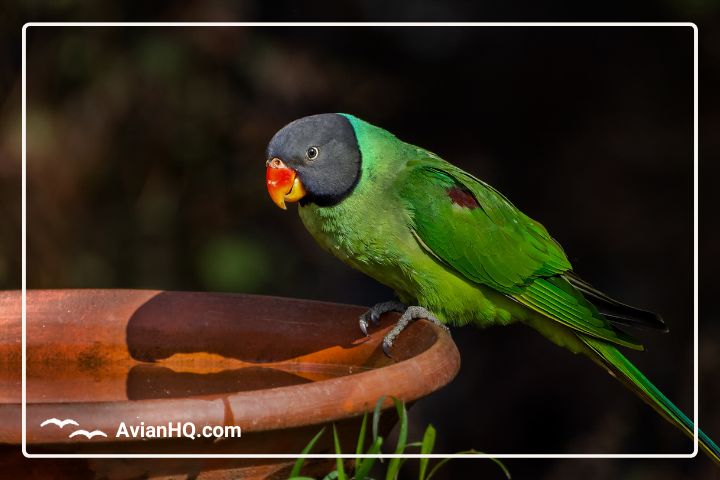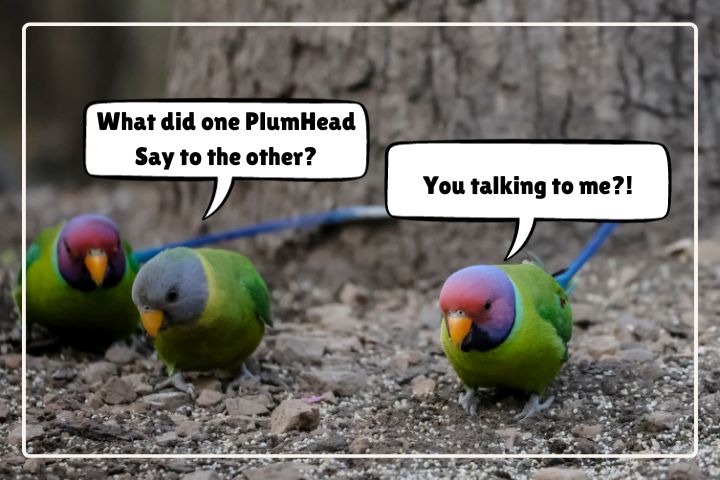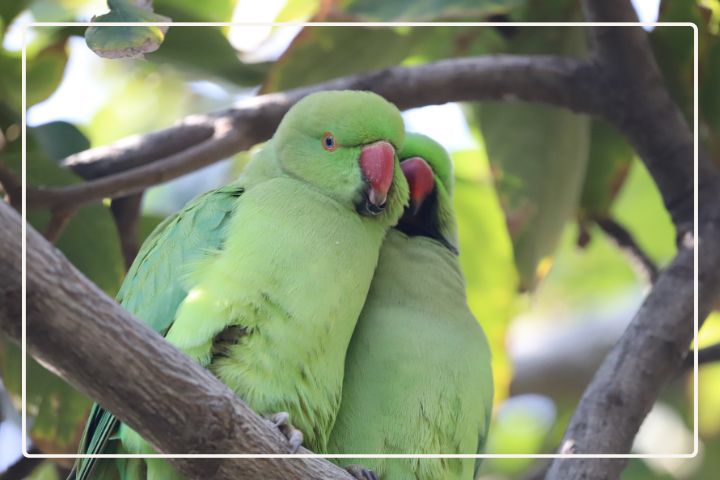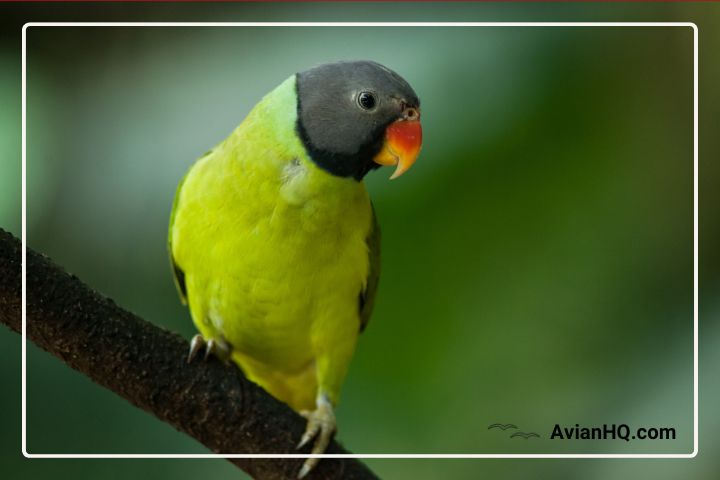Slaty-headed Parakeet: The Complete Guide
The Slaty-headed Parakeet (Psittacula himalayana) is a beautiful bird that makes a delightful pet for the right owner. This comprehensive guide will teach you everything you need to know about this parrot species, from their appearance and behavior to how to care for them properly.
An Introduction to the Slaty-headed Parakeet
The Slaty-headed Parakeet, sometimes called the Himalayan Parakeet, is a medium-sized parrot native to the Indian Subcontinent. They are admired for their unique plumage and vocal talents. While they can be challenging pets, these intelligent birds can make very rewarding companions when properly trained and cared for.
Appearance and Physical Traits
With their vibrant plumage and distinctive slate-gray heads, Slaty-headed Parakeets have an unmistakable appearance unlike any other parrot. Their most defining feature is the solid slate-gray coloration extending from the crown of the head down to the nape of the neck. Though these parakeets have a mostly green body, you’ll also notice their a maroon patches on their wings. This unique head profile gives rise to common names like Slaty-headed Parrot and Himalayan Parrot.
These parrots have a stocky body shape with a short tail and wings suited for swift, agile flight between the trees of their forest habitat. Adult birds reach approximately 36-42 cm (14-16 inches) in length from the tip of the beak to the end of the tail. Their wingspan, when fully extended, ranges from 35 cm (14 inches). Slaty-headed Parakeets are sexually monomorphic, meaning there is little external difference in appearance between males and females. However, males do tend to be slightly larger than females.
The average weight for these parakeets shows some degree of sexual dimorphism. Male Slaty-headed Parakeets typically weigh between 110-145 grams (3.9-5.1 oz). Females are smaller on average, weighing 95-135 grams (3.4-4.8 oz) at maturity.
Both sexes have a large powerful beak ideal for cracking open seeds and nuts. The beak itself has a red-orange upper mandible and a yellow lower mandible. Their eyes are fringed with white eye-rings and have brilliant yellow irises. The legs are a pinkish gray hue.
Juvenile Slaty-headed Parakeets less than one year old can be identified by their duller green plumage overall and darker beak and irises. Their eyes are initially a deep brown before lightening to the yellow coloration of adults. After their first molt around 6-12 months old, they develop the more vibrant adult plumage and fledging.
The variety of colors and textures in the Slaty-headed Parakeet’s feathers make them a real head-turner.
Plumage Details and Color Mutations
While most Slaty-headed Parakeets have green bodies, red bellies, and slate-gray heads, several color mutations exist due to selective breeding, including:
- Blue (entire body is blue-gray)
- Yellow (entire body is bright yellow-green)
- White (mostly white with some gray accents)
- Lutino (yellow with orange patches, red eyes)
Geographic Range and Habitat
Slaty-headed Parakeets have an extensive range spanning much of the Indian Subcontinent. They are native to India, Nepal, Bangladesh, Bhutan, Pakistan, and Myanmar. Within this region, they have adapted to thrive in a variety of habitats.
In the foothills of the Himalayas, you can spot these parakeets amongst the rhododendron and pine forests up to elevations of 1400 meters. They are equally at home amongst the Sal forests and mixed woodlands of the Indo-Gangetic plains. Slaty-headed parakeets will readily visit parks, gardens, and agricultural areas adjacent to forested regions across their range.
This adaptability allows them to inhabit a diversity of environments across their range. In Pakistan, they are found in the moist Deodar cedar forests of the Western Himalayas. Over in Bangladesh, you can observe them frequenting mixed bamboo and teak forests. Their flexible habitat preferences contribute to the Slaty-headed Parakeet’s widespread distribution across the Indian Subcontinent.
This range covers tropical and subtropical areas from the Indus River basin eastwards to the Brahmaputra River. With their athletic flight capabilities, these parakeets can easily travel between forest patches in search of food sources. Their ability to adjust to both pristine and disturbed habitats has allowed Slaty-headed Parakeets to maintain healthy populations within their historic native range.
Behavior and Temperament
Slaty-headed Parakeets showcase the boldness and intellect parrot lovers adore. At the same time, their advanced intelligence means they demand extensive attention and training compared to other companion parrots.
You’ll quickly notice their energetic, outgoing personality whether observing them in the wild or interacting with a pet bird. They are highly social and active creatures that need lots of toys and enrichment to stay engaged. These parakeets aren’t shy–expect to hear regular vocalizations and chatter from your exuberant feathered friend!
The Slaty-headed Parakeet’s remarkable intelligence gives them an aptitude for learning tricks and even mimicking speech when kept as pets. Their natural curiosity motivates them to be up to all kinds of mischief. This intellect combined with strong beaks mean they will test boundaries if not provided proper training.
New Slaty-headed Parakeet owners may find their bird to be nippy or headstrong at first. But with the right positive reinforcement training, they can become delightful, affectionate companions. Patience and persistence are key when taming these spirited parrots. Setting clear expectations using positive rewards will win out over frustration.
Their active, social nature makes them well-suited for aviaries where they can interact with humans and other birds. Whether living free in nature or bonded with a special person, the Slaty-headed Parakeet’s personality shines through!
Diet and Feeding of Slaty-Headed Parakeets
In the wild, Slaty-headed Parakeets forage for a diverse diet that allows them to thrive in their natural range. As pets, providing them a varied nutritional plan tailored to their needs is key to their health and happiness.
A staple of their diet should consist of a quality parakeet seed mix or pelleted diet. This gives them the protein, carbohydrates, and fats needed for energy and growth. Complement this with plenty of fruits and vegetables to provide fiber, vitamins, and minerals. Favorites like apples, oranges, leafy greens, carrots, and sweet potato offer beneficial nutrients.
A few times a week, supplement with people foods like cooked beans, pasta, and rice for extra protein. Offer nuts, sprouts, and healthy grains for added fat and amino acids. Cuttlebone is a great natural source of calcium important for bone health and egg production in breeding hens.
Always make drinking water freely available, as Slaty-headed Parakeets will drink regularly throughout the day. Filling their diet with this beneficial variety ensures your parakeet remains active and healthy year after year. Monitor their weight and adjust food amounts if obesity becomes a concern.
An occasional treat is great for bonding and training. Just don’t overdo high sugar or fat treats that can lead to health issues. With the right diverse diet full of color and texture, you’ll keep your Slaty-headed Parakeet’s body and mind nourished.
Lifespan
With proper care, Slaty-headed Parakeets can live 15-25 years. Their expected lifespan is reduced by poor nutrition, diseases, and stress.
Keeping Slaty-Headed Parakeets as Pets
The Slaty-headed Parakeet’s stunning looks and big personality make them popular and excellent exotic pets. However, their advanced intelligence means they are one of the more demanding parrots to keep as companions. With the right owner willing to invest time in training and interaction, they can make wonderfully engaging pets.
As highly independent thinkers, these parakeets will challenge boundaries if not given clear structure. Setting expectations using positive reinforcement training is crucial. You can’t dominate these birds like other pets – you have to outsmart them with patience and persistence.
Selecting a Healthy Bird
When choosing a Slaty-headed Parakeet, pick an active, alert bird showing natural behaviors. Look for bright, clear eyes, smooth feathers, and strong legs. The vent area should be clean. Skip birds that seem lethargic, underweight, or have soiled plumage. Seek out a reputable breeder who focuses on well-socialized birds.
Housing
These active parakeets need enough room to spread their wings. Aim for a minimum 24” x 24” x 36” cage for one bird. Bar spacing should not exceed 5/8” to prevent escape. Line the cage bottom with paper for easy cleaning. Provide several natural wood perches of varying widths and textures along with food and water bowls. Rotate new, bird-safe toys weekly to prevent boredom.
Taming and Training
Building trust takes time and consistency. Begin by hand feeding treats, then work up to step-up training onto your hand or arm. Use clicker training and positive reinforcement to teach these quick learners fun tricks like fetching objects or waving. Set boundaries but avoid punishment. Patience and praise are key to success. Provide at least an hour of supervised out-of-cage time daily.
Enrichment
Prevent destructive behaviors by providing ample enrichment. Rotate new toys frequently to pique their natural curiosity. Allow short sessions flying in a bird-safe room under supervision. Teach new behaviors and tricks to exercise their nimble minds. Provide shredding toys, bells, mirrors, and natural wood branches for entertainment. Shower perches also provide enjoyment.
Potential Health Issues
Slaty-headed Parakeets are prone to certain health problems including:
- Respiratory infections
- Obesity if overfed
- Feather damaging behaviors due to stress or boredom
- Egg binding in breeding hens
- Calcium deficiency if not provided cuttlebone
Schedule annual vet exams to catch any issues early. Having an avian vet fund prepared for emergencies is wise.
Finding and Selecting Your Slaty-Headed Parakeet
Looking to bring one of these exquisite parrots home? Here is what you need to know about finding a Slaty-headed Parakeet:
- Check with reputable breeders who focus on parrot breeding and hand-raising
- Rescue organizations may have Slaty-headed Parakeets needing adoption
- Avoid buying from pet stores, as these birds are often untamed
- Be prepared to be put on a waitlist, as good breeders may not always have chicks available
- Expect to pay $800 to $1500 for a hand-fed, well-socialized chick
When selecting your bird, look for signs of good health and proper early socialization. The key is finding an ethical, responsible breeder you can trust.
Preparing for Your New Feathered Friend
Before bringing home your Slaty-headed Parakeet, be sure you have:
- Properly sized cage in a safe area of your home
- Variety of perches, toys, and enrichment items
- High-quality pellet diet and nutritional supplements
- Dishes for food and water
- Bird-safe cleaning supplies
- Sturdy play stand for supervised out-of-cage time
- Bird first aid kit and avian vet fund
Breeding Slaty-Headed Parakeets
Looking to breed these remarkable parrots? Here’s what to know about Slaty-headed Parakeet breeding:
Breeding Season
In their natural range, Slaty-headed Parakeets breed December-March during the dry season. In captivity, they may breed year-round if conditions are ideal.
Nesting and Egg Incubation
- Use nest boxes approximately 8x8x16 inches
- Line with aspen shavings and provide nesting material
- Female lays 3-5 white eggs
- Eggs hatch in 23-25 days
- Parents take turns incubating eggs
Hand-Feeding Chicks
If hand-raising chicks:
- Chicks will need to be hand-fed every 2-3 hours from 6am to 8pm
- Use a syringe to deliver warm formula
- Stimulate vent area after feeding to encourage defecation
- Keep chicks warm with a brooder lamp
Weaning to an adult diet occurs around 8-12 weeks old. Consult an avian vet for guidance. Hand-raising baby parrots is very demanding—only attempt if you have proper training.
Conservation Status and Threats
While still widespread, Slaty-headed Parakeet populations have declined across parts of their range due to habitat loss and trapping pressures. Conservation action is needed to protect the future of these captivating parrots.
Slaty-headed Parakeets are currently classified as Least Concern by the IUCN Red List. However, researchers have observed decreasing populations in India and Nepal due to continued habitat degradation. There is also unsustainable trapping of wild birds for the pet trade.
Across South Asia, logging, agricultural expansion, and development projects have led to deforestation and fragmentation of woodland habitats these parakeets rely on. Their nesting cavities are often lost when dead trees are removed. As humans encroach further into their range, persecution as crop pests also threatens local populations.
Trappers supply an ongoing demand for wild-caught Slaty-headed Parakeets in the global pet market. Often, trapping practices are inhumane or involve chick poaching from nests. Captive breeding programs are expanding, but many birds sold commercially are still sourced from the wild.
While not yet endangered, increased conservation action is needed to maintain healthy populations of these charismatic parakeets. Expanding protected forest habitats and regulating the pet trade are key steps that can secure their future. With commitment from governments and citizens, we can safeguard Slaty-headed Parakeets for generations to come.
Fascinating Slaty-Headed Parakeet Facts
- Known for their excellent mimicking ability—they can learn words and phrases
- Groups rest communally in tree cavities at night
- lifespan in captivity can reach over 30 years with proper care
- Young birds have dark brown irises that lighten to yellow as adults
- Their Latin name “Psittacula” means “little parrot”
Bringing This Amazing Parrot Into Your Life
The Slaty-headed Parakeet stands out for its exceptional intellect and stunning looks. While they demand lots of attention and training, they can be incredibly rewarding companions for dedicated owners. We hope this guide gave you a comprehensive overview of their care and characteristics. Let us know if you have any other questions as you prepare to welcome one of these incredible parrots into your family!








You got a very good website, Glad I noticed it through yahoo.